1957 BMW Isetta 300
It Comes From a Time When Frugal Driving Was a Necessity. But Seldom Has an Economy Car Drawn Such Attention.
WE CAME AROUND the corner and started looking for the owner’s address, but we needn’t have bothered, because there in a driveway a few houses down was what looked like an enormous honeydew melon set on end, with tiny wheels and a door in it. There is no mistaking a BMW Isetta 300. We started grinning at the sight of it, and we couldn’t stop chortling during the whole assignment. It was that much fun.
David Raab, the car’s owner and avid micro-car collector, shows me how to inject myself into the thing, and then I get comfortable and pull the door closed. The seat is ample for two. The windshield is but a few inches from my face, and the steering wheel, which has one universal joint and a gimbal, swings in and up with the door and folds out to where a tray table would be in economy class on an airplane. Now I know what a duck embryo feels like.
I familiarize myself with the instrument on the dash. I say “instrument” because there is only one, and that is a speedometer. There is a tiny blue light that illuminates if your brights are on, and a tiny red one to show charging — or the lack of it — and an indicator light but that is it. There is no gas gauge, oil gauge or temperature gauge. But there is a decal on the inside of the windshield telling you the shift points for the transmission.
There’s no fuel pump either. Just as with a motorcycle, you turn a little valve behind your seat from the center — or off position — to the right and gas runs down to the carburetor by gravity. When you do that, you are running on your main tank, which holds about three gallons of gas. You drive until the engine sputters, and then you turn the lever all the way to the left and you are on your reserve tank, which contains about ¾ of a gallon of fuel to get you to the next gas station. The Isetta gets 46 miles to the gallon, so you aren’t in much danger of running out.
Not Your Typical ’50s Car
I feel around for the shift lever, (it’s on the left) and we are ready to go. I twist the key and the engine starts after a couple of turns. It takes a bit of ginger jiggling of the throttle to keep the 298cc air-cooled single-cylinder four-cycle motor running until it warms up a little. The engine makes that typical putt-putt putt-putt sound of a motorcycle engine because that’s what it is. And as with any one-lunger, there is a fair amount of shaking that sort of mellows out to a vibration as you give it more fuel.
The Isetta pedals are — as with many older European cars — teensy and close together. My size 11½ shoes scuff things as I work them. They are in the usual order, with the clutch on the left, brake in the center and gas pedal on the right.
The gearshift reminds me of the VW Beetle’s broomstick-in-a-bucket-of-ice feel, but I find low, and give the minuscule machine a little throttle and we are off. Acceleration is good off the line, but I run out of revs in low at about 12- 15 miles per hour and shift into second. The car has a four-speed transmission and will do 53 mph, but it can get a little squirrely in a crosswind at that speed because it only weighs 770 pounds.
You definitely wouldn’t want to get into a road rage dispute while driving this micro-car either, because a short-tempered weightlifter could easily push you over on your side. You also don’t want to pull up too close to a parked car in front of you because if your engine quits, you will not be able to back up and open your door. You could climb out through the sunroof, but that would be undignified.
On the other hand, the Isetta length is about the same as the width of other cars, so you could just pull into a tight parking place nose-first and step out onto the sidewalk.
Close Encounter of the Scary Kind
After a few laps around a parking lot to get to know the car, we head for the highway. I come to a signal and stop… and am suddenly overwhelmed by the colossal grumble of a big diesel engine and the screech of air brakes. Heat and diesel fumes come wafting in the sliding side windows. I look in the rearview mirror and spot a radiator the size of a theater screen. And then I realize that the driver of the behemoth 18-wheeler behind me cannot see the Isetta at such close range…but hopefully he can smell my fear. When the light turns green he proves he is a sporting fellow though, because he gives me time to get far enough out in front of him to see me before taking off himself.

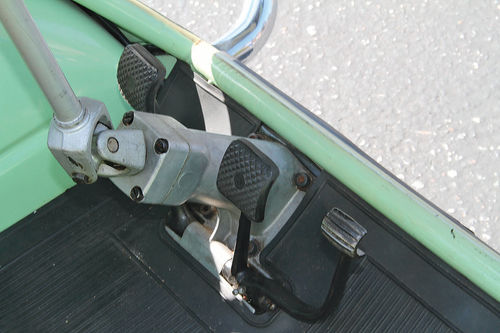
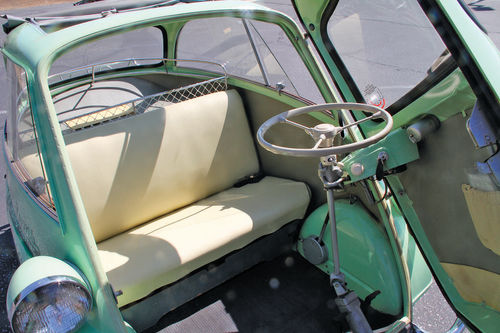
It Started in Italy and Spread From There
Pierluigi Raggi and Ermenegildo Preti first conceived the idea of the Isetta in 1953 for Renzo Rivolta, owner of Iso SpA in Italy. Iso made refrigerators, scooters and motorcycles, but reasoned that there could be a market for a small, economical mass-produced automobile in post-war Europe.
The company built the original Italian Iso Isetta using a two-cycle 236cc 9.5-horsepower scooter engine. According to legend, the engineers simply placed two scooters beside each other and put a small refrigerator on top of the bikes to create their original concept car.
The little Isetta was a hit at the automobile show at Turin and was put into production. But Rivolta also got the bright idea to license out production of the car to other countries so he could continue in his quest to build high-end sports cars. As a result, the Isetta was built in France, England, Spain and even Brazil, but it was the BMW version in Germany that was most successful.
Sales of BMW’s frumpy post-war 502s and 507s, known as baroque angels because of their rather pretentious styling, had been lackluster to the point where the firm was considering a merger with Mercedes-Benz. But then the Isetta came along and became the first mass-produced automobile BMW ever made. Every aspect of the car was re engineered and improved to the point where nothing fits between a BMW-built Isetta and its predecessor the Iso Isetta. I can’t speak for the other makers, but the build quality of the BMW version is undeniably excellent.


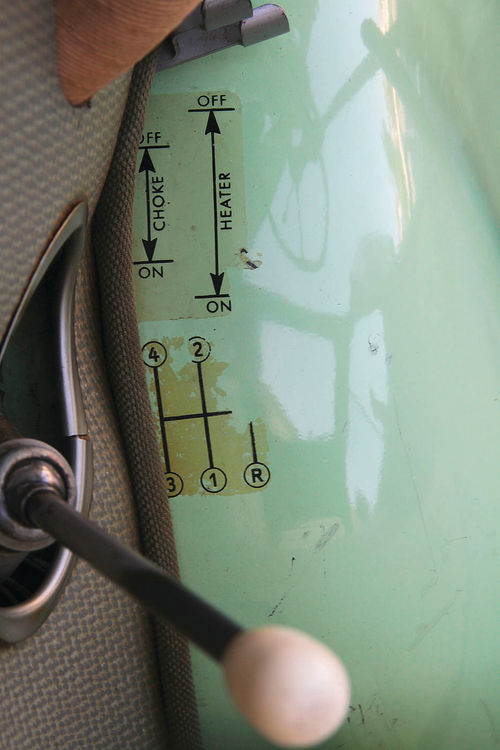
The car was successful beyond BMW’s most optimistic projections, and it probably saved the company from extinction. In the early ’50s the average West German could not afford an automobile because the country was still recovering from defeat in World War II, so motorcycles became a popular form of transportation even though it rains a lot in Germany, and it snows in the winter. Also, gasoline was in short supply after the war because it all had to be imported, so a car was expensive to operate. But some Germans could afford a micro-car that was essentially a motorcycle with an all-weather body.
At the same time, slightly larger European vehicles such as the Hillman Minx and the Volkswagen Beetle were making sales inroads in the United States, so a few importers brought BMW Isettas into this country to see how they would do. About 8500 of the BMW-built cars were sent to America, and it’s estimated that 1000 still survive.
At the same time, slightly larger European vehicles such as the Hillman Minx and the Volkswagen Beetle were making sales inroads in the United States, so a few importers brought BMW Isettas into this country to see how they would do. About 8500 of the BMW-built cars were sent to America, and it’s estimated that 1000 still survive.
The British Difference
The Lilliputian Isetta is sort of a mid-engine car, though it could also be said that it is a side-engine car, with the engine mounted amidships on the passenger side. That posed a problem on the British models because the Brits drive from the other side of the car, so the driver and the engine ended up on the same side, creating a severe weight bias. And adding to that, the British made their version of the Isetta a three-wheeler in order to thwart their tax laws. (The Continental and American version has four wheels with a 19-inch rear axle, but more on that later.)
This meant that the British Isettas needed a sixty-pound ballast weight on their passenger side to counterbalance the weight of the engine and driver. That made the vehicle a bit less tippy, but they were still pretty vulnerable in a hard right turn. Incidentally, a bolt was inserted into the transmission on Isettas in the U.K. to block out the reverse gear so the car would be taxed as a motorcycle and not a car. But the Isetta was in fact an all-weather go-cart, right down to its welded tube chassis, more than anything else.
The BMW Isetta may have been only marginally successful in the United States, but it set off a wave of micro-car innovation in Europe. There were the German Heinkels, Goliaths, DKWs and Messerschmitts, the French Citroen 2CVs, and the Bond mini-cars in Britain. The smallest of all was the Peel, built on the Isle of Man in England. It transported only one highly compressed individual and had an even smaller engine than the Isetta. Of course, there may have been yet smaller cars over there but they couldn’t be seen without the aid of a magnifying glass.
From 300 to 600 to the History Books
But even though the little BMW Isetta 300 achieved some success in Europe, its run was fairly short-lived. Fiat came out with its 500, popularly known as the Bambino, in 1957 and it turned out to be a step up in comfort and speed. To its credit, BMW answered the challenge by offering its four-passenger Isetta 600 in 1957.
The Isetta 600 had an extended wheelbase to allow for two seats and a side door for the rear passengers. It also sported a 596cc engine that could propel it to a hair-raising 63 miles per hour. The 600 had a standard-width rear axle and a wheel at each corner too, which made it more car-like. (It also had a stretched look that made it appear more like a minivan version of the Isetta.) But while the 600 got rave reviews and sold well at first, the heyday of the micro-car had passed.
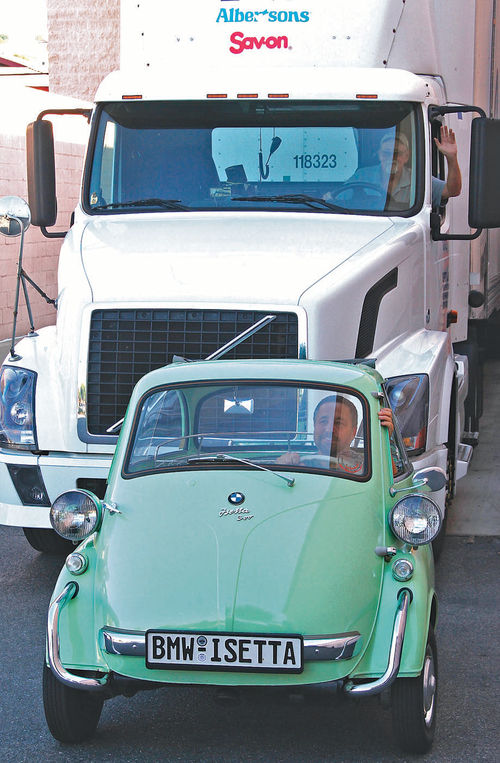
My Friend Had an Isetta Daily Driver
A good friend of mine, Jerry Kill, drove an Isetta to work for a couple of years in the late ’50s, so we took him along on our test drive as a consultant. He told me what it was like to own and maintain one. “You had to tighten everything up about once a month on the thing because of the vibration. Also, you needed to pull the spark plug every month or two and clean and gap it. Otherwise you would be down on power. It got great fuel economy though.”

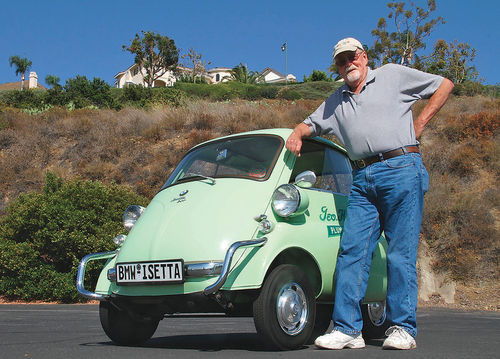
Jerry also explained that the engine drove its chain sprocket to the rear wheels through a couple of rubber universal joints and a short driveshaft. He emphasized that the rubber joints were critical, and that if they went out, you were stuck. They were also hard to get at. The rear axle was only 19 inches wide because a wider axle would have made a heavy and expensive differential necessary. As it is, the two back wheels turn in unison and just scuff a bit going around corners.
Jerry also explained that the engine drove its chain sprocket to the rear wheels through a couple of rubber universal joints and a short driveshaft. He emphasized that the rubber joints were critical, and that if they went out, you were stuck. They were also hard to get at. The rear axle was only 19 inches wide because a wider axle would have made a heavy and expensive differential necessary. As it is, the two back wheels turn in unison and just scuff a bit going around corners.
David Raab, the owner of our test car, took Jerry out for a spin which brought a big smile to his face, and then David took me for a longer ride and drove with much more ease and dispatch than I was able to manage. With him behind the wheel we did just fine in street traffic. But a run on the freeway would have been asking a lot of the little machine. I can see that this little car would have been ideal in Stuttgart, Paris or London with their narrow labyrinthine streets, but out in the Western United States it was only barely adequate.
They Do Have a Following
Nevertheless, micro-cars have become major collectables in the U.S., with the BMW Isetta being the most sought-after. They have been known to sell for as much as $35,000 at auction for a good restored example, and a nice driver will set you back $25,000.
1957 BMW Isetta 300
GENERAL
Mid-engine, rear-drive micro-car
Top speed 53 mph
Fuel consumption 46 mpg
Cruising range 219 miles
ENGINE
Type 1-cylinder, air-cooled
Displacement 298cc
DRIVETRAIN
Transmission Four-speed manual
MEASUREMENTS
Wheelbase 58 in.
Length 89.8 in.
Height 52.6 in.
Width 54.3 in.
Weight 770 lb.
Track (f/r) 47.2/20.4 in.
Fuel capacity 3.4 U.S. gal.
Incidentally, all of the Isettas built for the American market had the chrome corner nerf bars on the front, and sealed beam headlights. Raab’s example also has the little pouch in the front door and the “dog’s breath” heater and defroster that works off the exhaust manifold, all deluxe items, along with a chrome luggage rack at the rear. It only sports one windshield wiper though, with a bump on the passenger side of the door/cowl for a second one.
Raab loves his little Isetta, which only has 7158 miles on it, and he loves his pristine contemporary Goliath as well. And I can see why. For one thing, e v e r y w h e r e we stopped, women came over to compliment him on his adorable little car. After the shoot we said our goodbyes and left him holding forth with two attractive young ladies.
All I can say is, what was I thinking, driving around in my big old 1956 Pontiac as a young swain trying to meet girls? If I’d only known that a micro-car would have gotten me a lot further and cost a lot less.
















